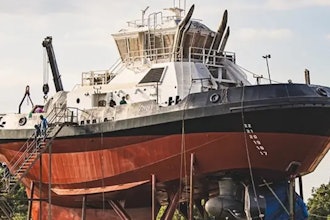
MINNEAPOLIS (AP) — An updated environmental review released by a state agency Monday found no serious threat to Lake Superior if crude oil ever leaked from a new pipeline to replace Enbridge Energy's aging Line 3 across northern Minnesota.
State regulators ordered the update after the Minnesota Court of Appeals in June declared that an earlier review, issued in February 2018, was inadequate because it failed to specifically address the potential impacts of a spill into the Lake Superior watershed.
Line 3 carries Canadian crude from Alberta and clips a corner of North Dakota on its way across Minnesota to Enbridge's terminal in Superior, Wisconsin. The replacement would double the capacity of the existing line, which was built in the 1960s and is increasingly subject to cracking and corrosion. Environmental and tribal groups have been fighting the project because of the potential for spills in the Mississippi River headwaters region — an important wild rice growing area — and other pristine waters, and because the oil would contribute to climate change.
The update issued by the state Department of Commerce modeled the potential impacts of a spill where the replacement pipeline would cross Little Otter Creek. The department said a spill there would be more likely to enter the St. Louis River, with the potential for flowing downstream into Lake Superior, than other sites it could have modeled.
A public comment period on the update runs through Jan. 16. Interested parties will also be allowed to comment in person before an administrative law judge in Duluth on Dec. 19.
Officials with Enbridge, based in Calgary, Alberta, welcomed the report. They told reporters that if the Public Utilities Commission deems the update adequate, they hope to start construction of the Minnesota and North Dakota segments of the replacement pipeline in mid-2020. Construction would then take seven to nine months. The upgraded Canadian and Wisconsin segments are already in service. Enbridge estimates that the 350-mile (560-kilometer) Minnesota segment will cost $2.6 billion, with the entire U.S. segment costing $2.9 billion.
The hypothetical modeling considered what would happen in the event of a ruptured pipeline at full flow near the creek if Enbridge failed to fight the spill within 24 hours — essentially a worst-case scenario. Enbridge officials said their actual response would include immediate and aggressive moves to address the spill and begin the cleanup.
The report said some oil might float down the St. Louis River to a dam where it would mix with the turbulent water. It said the most significant environmental impact would be potential short-term effects on fish right below the dam due to toxic components in the oil. But past the dam, it said, any oil remaining on the surface after 24 hours would likely wash up on shore without reaching Lake Superior.
“The modeling confirms there is no introduction of risk to Lake Superior with a crude oil release,” project director Barry Simonson said on a conference call with reporters.
Climate change activists said the updated review didn't go far enough.
“The PUC has produced yet another inadequate review that fails to recognize that this pipeline would pose an unacceptable risk to Minnesota's clean water and should never be built," said Margaret Levin, director of the Sierra Club's Minnesota chapter. “Now it's more important than ever that Governor (Tim) Walz and the Pollution Control Agency do everything in their power to stop this dirty tar sands pipeline once and for all.”





















